Salvia yangii
Previously known as Perovskia atriplicifolia, Russian sage was recently renamed Salvia yangii, and like rosemary which was also recently reclassified, is now regarded as a member of the Salvia genus.
Added to the genus in 2017, this mint family plant looks much like lavender but smells like sage. That’s where its common name comes from! Well, the second part, at least…
Native to the steppes and hills of central and southwestern Asia, Russian sage is a flowering herbaceous perennial that grows to just three or four feet tall.
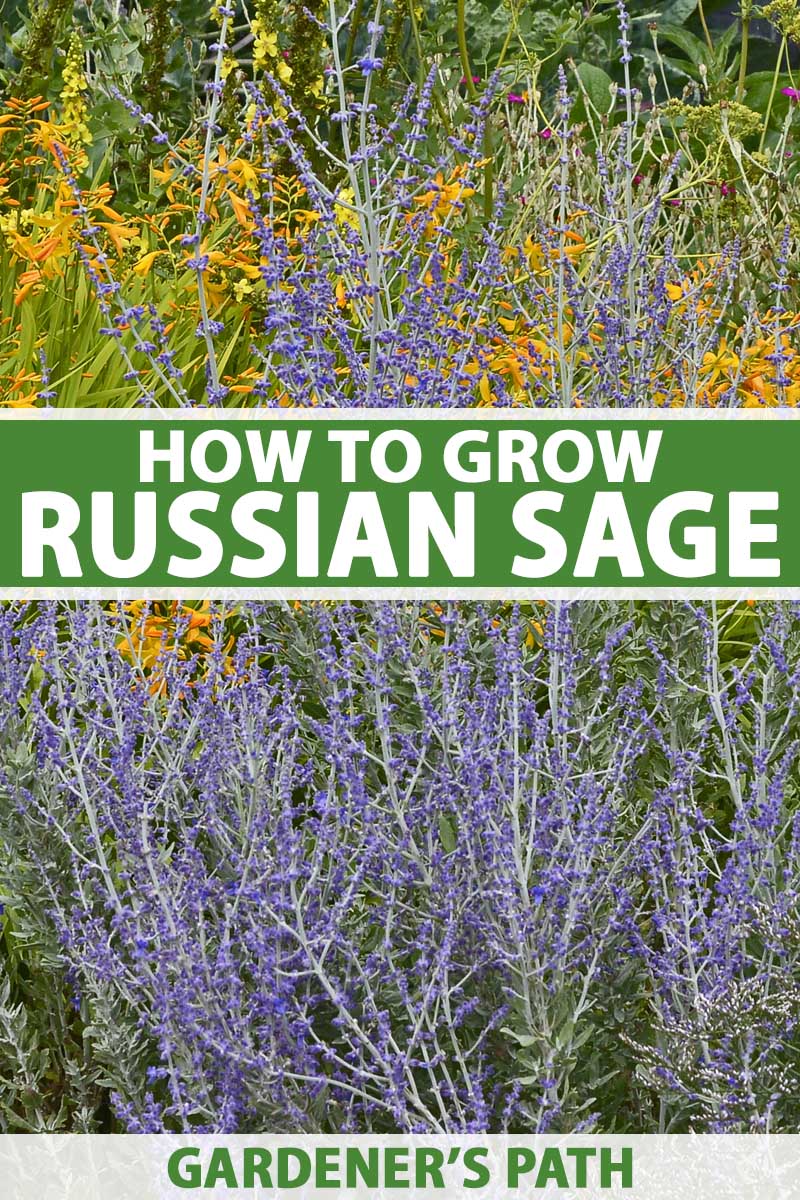
We link to vendors to help you find relevant products. If you buy from one of our links, we may earn a commission.
This subshrub has a wonderful aroma and attractive appearance that make it a prime candidate for any ornamental garden in USDA Hardiness Zones 3 to 9.
Ready to try your hand at growing this elegant, fragrant plant? Here are the topics we will tackle in this article:
What You’ll Learn
What Is Russian Sage?
Russian sage is a semi-woody flowering perennial that belongs to the mint family, Lamiaceae.
It is often used in cottage gardens, where it adds visual appeal when grown among ornamental grasses and other flowering perennials.

Several cultivars have been developed, most of which are distinguishable by their height.
And there are several related and newly reclassified species within the Salvia subgenus Perovskia, many of which share the same native range and general appearance, but offer different flower colors or other distinguishing features.
S. yangii grows up to four feet tall in an upright fashion. It has distinctive green-gray aromatic leaves and blue-purple flowers.
The fuzzy tube-shaped flowers grow in pairs on showy panicles, and the racemes that hold them are completely covered in blooms when in season, from near the base to the tip.
Silvery green leaves are arranged in opposite pairs on long stems beneath the flower stalks.
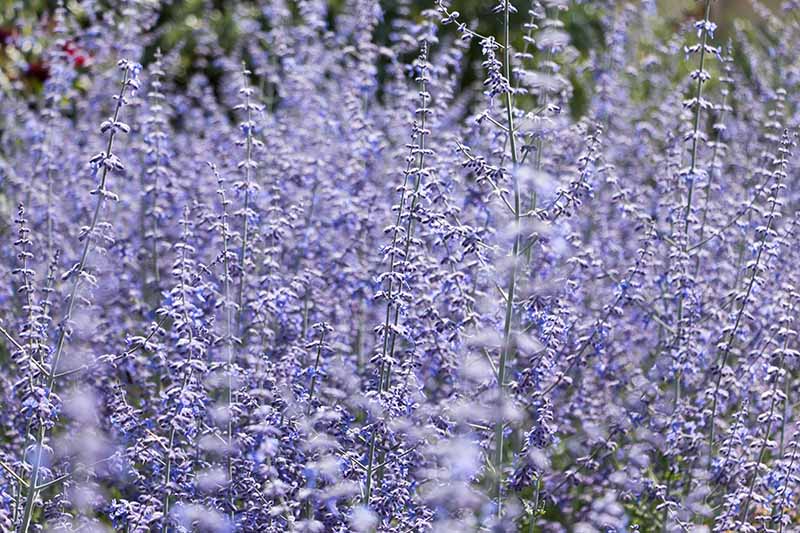
Though many gardeners love the scent of the leaves when crushed, describing it as akin to the common culinary herb sage or a combination of that and lavender, others claim it’s more off-putting, a bit like turpentine.
Pollinated flowers give way to tiny, dark brown, nut-like fruits.
Although this plant does have a long history of use in traditional medicine in its native range for treating fevers and soothing upset stomachs, among other ailments, it is more often grown today for its ornamental value.
The flowers are considered edible, with a sweet and slightly peppery flavor, or they may be used in dye making.
Researchers are also studying this plant for its potential use in phytoremediation, pulling heavy metal contaminants out of the soil.
Note that the leaves contain a potentially toxic compound and should not be eaten. Please proceed with caution when experimenting with culinary use of any plant grown in the garden that you have not consumed before.
Consulting with a trained herbalist or medical professional is recommended before ingesting this plant.
Wearing gloves when you work with this plant is also recommended, as it may cause skin irritation in some people.
Cultivation and History
Until 2017, Russian sage was known botanically as Perovskia atriplicifolia. It was reclassified as Salvia yangii to reflect its inclusion in the Salvia genus.
As a member of the mint family, this plant can spread quickly and grows well in temperate climates.
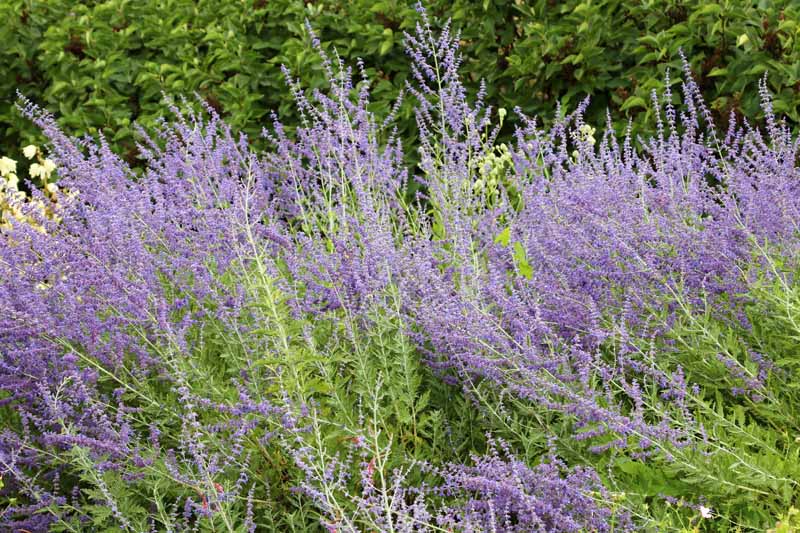
Russian naturalist Grigory Karelin named this plant in 1841, and he collected tens of thousands of specimens in his time and explored areas within this plant’s native range.
English botanist George Bentham formally described the plant in 1848, based on a specimen collected by British botanist and naturalist William Griffith in Afghanistan that has been preserved to this day in the herbarium at Kew Gardens.
Native to Central Asia, including parts of Pakistan and Afghanistan as well as Tibet – not Russia, as its common name would suggest – it was named Perovskia in honor of Vasily Perovsky, an Imperial Russian general and appointed military governor of the Russian province of Orenburg.
Atriplicifolia denotes the similarity of its foliage to saltbush, and other members of the Atriplex genus.

Since its first introduction to the UK, several notable gardeners have fallen in love with this plant and promoted its cultivation, including Irish wild and cottage gardening proponent and author William Robinson, and horticulturist and former director of the US National Arboretum John Creech.
The Royal Horticultural Society documents ‘Hybrida’ as the first hybrid cultivar, selected at Hampshire Nursery in the 1930s, and Russian sage was selected as the Perennial Plant Association’s Plant of the year in 1995.
Russian Sage Propagation
Russian sage can be started from seed, from stem cuttings, or by dividing mature plants. You can also transplant seedlings or nursery plants into the garden.

Established plants will self-sow and sometimes spread via underground rhizomes as well, under ideal conditions.
Note that unlicensed propagation of some cultivars is prohibited, depending on their patent status.
From Seed
You may sow Russian sage seed at any time of the year, as long as you opt to do it indoors.
Starting seeds at least six to eight weeks before the last predicted frost in your area is recommended, if you hope to plant them out the following season.
Begin by cold stratifying the seeds in a plastic bag stored inside the refrigerator at a temperature around 40°F for a period of 42 days. This will speed up and increase the rate of germination.
Next, fill a seed tray with moist seed starting mix.
Spread the seeds on the top of the soil, spacing them at least half an inch apart. You can thin seedlings later on if they are too crowded, which can happen if they shift around when you water.
Gently press the seeds to make sure there is good contact with the soil. Cover with a very light layer of soil or sphagnum moss.
Put a plastic cover on top of the seeds, and place the tray in an area out of direct sunlight with consistent temperatures around 60 to 65°F.
While you are waiting for seeds to germinate, lift the cover and mist them with water from a spray bottle once or twice a day, whenever the soil surface is dry to the touch.
Your seeds should germinate in around 90 days, often much more quickly. If you have not seen any signs of germination after 120 days, they may have failed to germinate. Toss them and start over if this is the case.
Once the seeds begin to sprout, you can remove the plastic cover. Move the tray to a sunny window, or position it under a grow light. Continue to water as needed.
When the seedlings are one inch tall, you can transplant them into individual 12-inch pots filled with potting soil, with some landscaping sand mixed in to promote good drainage.
Transplant into the garden in late spring or early summer. Plants grown from seed will bloom for the first time in their second year.
Cold stratified seeds can also be broadcast onto a prepared planting area outdoors, after the risk of frost has passed. Water in gently, and keep the planting area moist until seedlings sprout.
From Cuttings
This method is much quicker than starting from seed, with satisfying results and a good success rate.
Softwood or semi-hardwood cuttings are both suitable for rooting, and each gardener seems to have his or her preferred method, depending on the time of year, with reported varying levels of success.
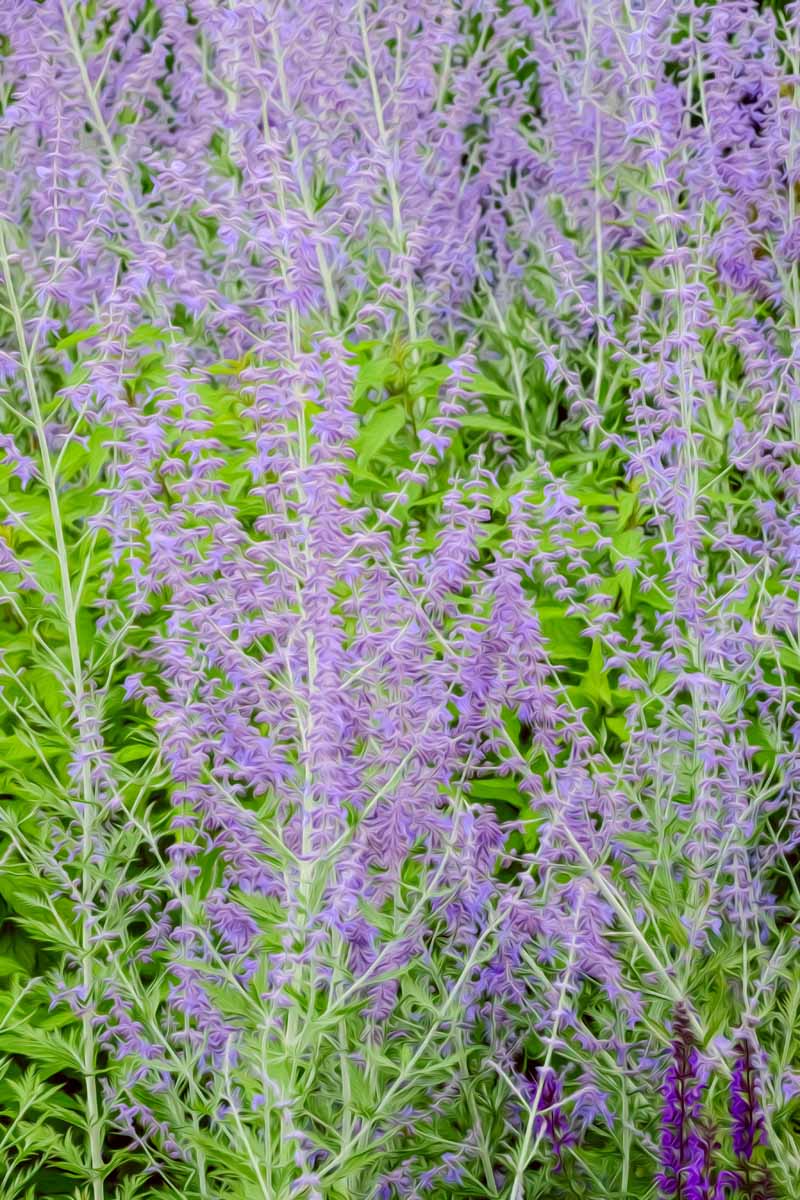
Softwood cuttings may be taken in spring, and semi-hard cuttings can be taken in the summer.
Our best recommendation is to take cuttings at a time when you know you’ll be able to care for them, and when plants are looking their healthiest.
To propagate Russian sage from cuttings, choose a healthy, mature plant and take several cuttings that are each about four inches long, using a clean pair of pruning shears. Make your cuts just above a leaf node.
Strip off all of the leaves except for a few at the tip of each cutting. Remove any buds or flowers.
Dip the cut end of each in powdered rooting hormone if you wish. Russian sage will root without supplementary rooting hormones, but your success rate may be higher if you use it.
Place each cutting in a 12-inch well-draining container filled with moist sand or your choice of soilless medium, with the bottom of each inserted about an inch deep.
Place your cuttings in a brightly lit environment indoors in a protected area, at a temperature of around 60°F.
The cuttings should begin to produce pale white roots within a few weeks, and they will begin putting on new growth as roots become established.
Keep the soil moist in the meantime. You can plant your rooted cuttings out in the garden when they reach about a foot in height.
From Seedlings/Transplanting
Russian sage can be transplanted into the garden as soon as the risk of frost has passed.
Harden off seedlings or rooted cuttings before planting. You can do this by bringing them outdoors to a partially sunny and protected area for an hour on the first day, bringing them back inside, and increasing the time spent outside each following day by about an hour until they can stay out for the whole day.
Dig a hole that is roughly two and a half feet wide and about as deep as the root ball of the plant, typically about a foot deep when plants are mature enough for successful in-ground transplanting.
Carefully place the plant in the hole, taking care not to damage its fragile roots. Backfill the soil, tamping down lightly around the plant, then water deeply.
From Division
Division can be helpful if you want to control the growth of your existing Russian sage plants. It can also encourage them to bloom more vigorously. Of course, it’s also a wonderful way to get new plants growing in your garden!

You can divide your plant every three years, and it’s best to do so in the spring or fall. Divide before your plant is in active bloom, or just after flowers have finished but before plants go dormant for the winter.
You may opt to prune stems to about six to eight inches high with a pair of clean garden trimmers before dividing in the fall.
Remove the plant from the ground with a shovel, digging out wide and deeply enough to prevent causing damage to the roots. If you can’t dig the whole thing up, work in sections.
Gently remove some of the excess soil from around the roots so you can see what you’re working with, and then divide the parent into clumps with roots attached, either into thirds or in half, depending on the size of your plant.
Larger plants may need to be split into more pieces.
Separate the roots gently with your hands, and place the divisions in a shallow tray of water to keep the roots moist while you work.
Dig a hole that is as deep as the length of the roots for each of the divided sections. Add some compost to the soil to provide supplemental nutrients as needed.
Set the crown of each division at the surface of a hole. Pack dirt around the roots as you work, repeat with each division, replant the parent, and then water deeply.
How to Grow Russian Sage
Plant Russian sage in full sun and well-drained soil. The plants should be spaced 18 to 24 inches apart, depending on the cultivar and the look you are trying to achieve in your garden.
Hedge plants can be spaced more closely together.
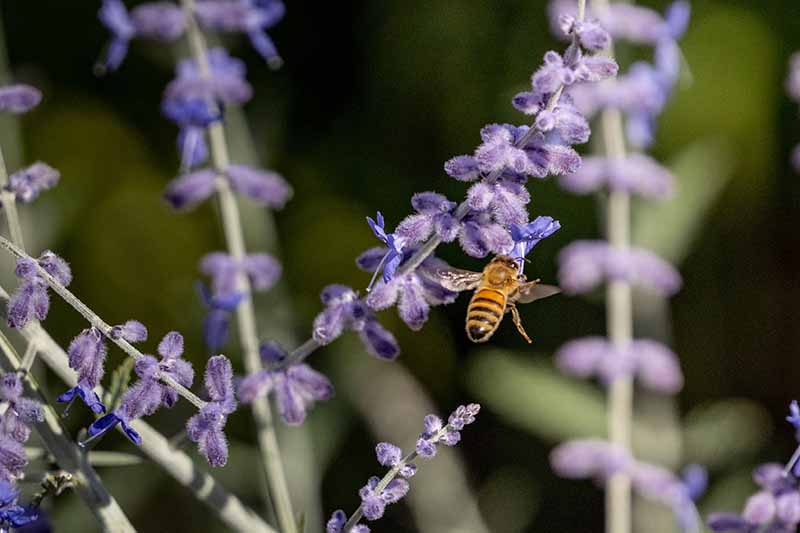
Remember that airflow is also important. If you frequently experience wet weather where you live, you may want to provide extra space between your plants to prevent rot and improve airflow, to inhibit fungal disease and facilitate quicker drying of the foliage after rain.
This species is a good choice for growing in poor-quality soil, even those types that are somewhat rocky, sandy, chalky, or alkaline, as long as they are moderately moist to dry.
In fact, S. yangii prefers a pH above 7.0 and will not tolerate soils that are extremely acidic. It can tolerate salty seaside conditions as well.
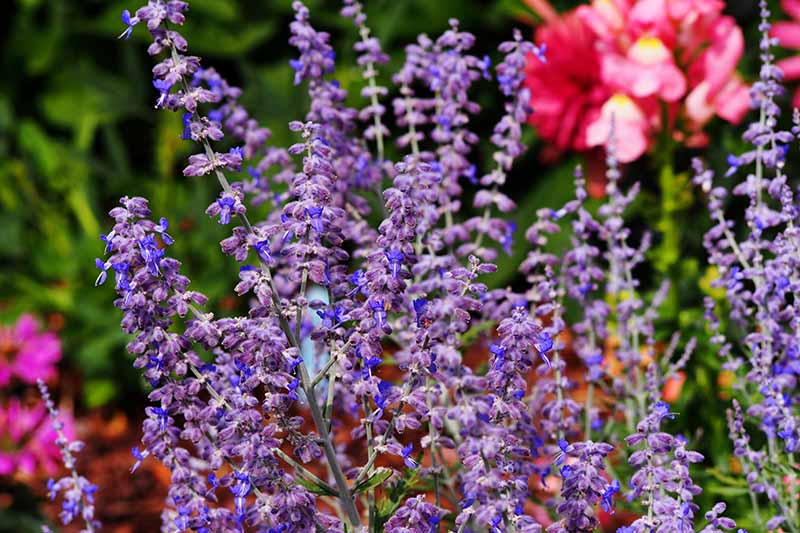
Water deeply and often during the first growing season. This will help the plants develop strong root systems as they become established.
Let the soil dry out between waterings, providing at least an inch of supplementary water per week if rainfall is minimal.
In the second year and beyond, Russian sage plants are much more drought tolerant. Provide supplementary irrigation during prolonged periods of hot weather or severe drought.
After plants become established, they will be relatively hardy with few pest or disease problems.
You may want to stake them, as certain varieties tend to flop over as the season progresses, especially when they are young or if they are growing in partial shade.
This is not necessary for the health of the plant, but can help to neaten up the appearance of these plants in your garden.
Fertilize once per year, ideally before new growth appears in the spring. Just apply a light top dressing of compost or a balanced fertilizer.
Mulch can be used to help protect your plants in the winter, and to help moderate soil moisture levels. Though they are frost tolerant, wet winters can lead to rot.
Apply a one-inch layer of organic material like bark, keeping it away from the crown of the plant.
Growing Tips
- Plant in full sun.
- Grow in well-draining, alkaline soil.
- Fertilize once per year in early spring.
Pruning and Maintenance
Deadheading your plant is not necessary. However, you should prune each year in the early spring. Cut mature plants back to about 12 to 15 inches above ground level.
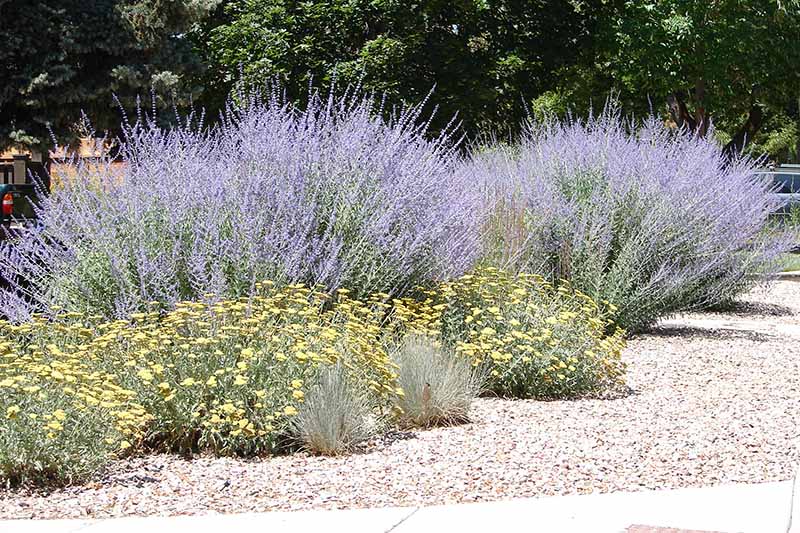
Be sure to clip the flower stalks before they set seed to prevent unwanted volunteers from popping up, and divide larger plants as needed.
Seeds can also be saved for later planting, but note that hybrid cultivars may not grow true to seed.
In very cold northern climates, typically that of USDA Hardiness Zones 5 and under, plants may die back completely to the ground in the winter.
You may choose to cut them back entirely to the ground and mulch lightly to protect the roots and crowns from wet winter weather in these areas. Springtime pruning is not required if this is the case.
Cultivars to Select
There are several cultivars and hybrids of Russian sage to choose from.
To avoid customer confusion, all of these will often still bear the old genus name and species on labels, Perovskia atriplicifolia, and they share the same care requirements. They differ in size, overall appearance, and bloom time.
Newer cultivars tend to be more compact, in terms of overall stature as well as flower arrangement, and more closely packed flowers serve to produce more visual impact in terms of dense color.
In addition to the species plant, the following cultivars are a few of our favorite varieties of Russian sage that you may like to grow in your garden.
Blue Spritzer
Also known as ‘Balperobritz,’ this cultivar has pale lavender-blue flowers with light purple calyces. Widely spaced out over the racemes, they have an airy and light appearance.
Blooming from summer into fall, Blue Spritzer™ reaches a modest height of two to three feet, with a mature spread of about four feet.
The silvery-green leaves have a rounded shape, and this variety has a bushy, vase-shaped habit.
Blue Steel
Producing lots of dark lavender-blue flowers and purple calyces, ‘Blue Steel’ is sure to make an impact in the garden. Its leaves are rounded and shallowly serrated with wavy margins, and it has a bushy habit.
This variety is said to have a more citrusy scent than others. Plants can be expected to reach a mature height of two to three feet with a similar spread, and flowers bloom from early summer through early fall.
Seeds are available from True Leaf Market.
Denim ‘n’ Lace
Named for the blue hue of its flowers and the fern-like appearance of its foliage, this newer cultivar has densely clustered blooms for maximum colorful impact.
Reaching a mature height of nearly three feet with a spread of just under four feet, this mid-sized variety blooms from mid-July to mid-October.
Plants are available from Burpee.
Filigran
‘Filigran’ is said not to be as well-acclimated to colder growing zones as some of the other cultivars on this list, preferring the climate of USDA Hardiness Zones 5 to 9.
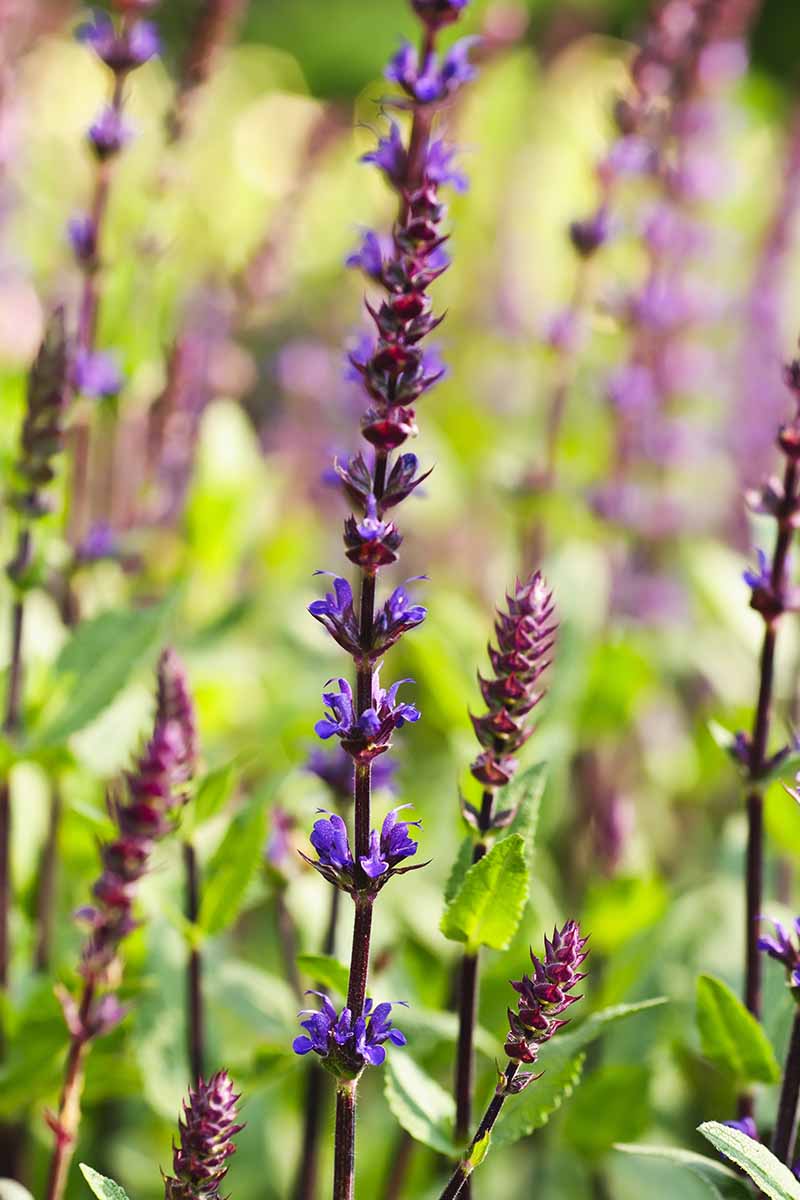
With a cultivar name that is the German word for filigree, it has lacy, feathery, fern-like foliage.
‘Filigran’ blooms from early summer through mid-fall with lavender-blue flowers surrounded by purple calyces.
It has a more upright growth habit than other cultivars as well, reaching a height of three to four feet – or more – with a mature spread of up to eight feet.
Little Spire
‘Little Spire’ also prefers warmer growing conditions, thriving in USDA Hardiness Zones 5 to 9.
With showy purple-blue flowers that bloom in summer and early fall, it is a compact variety that grows to just one or two feet tall at most.
Plants are available in #1 containers from Nature Hills Nursery.
Longin
A classic, older cultivar, ‘Longin’ is similar in appearance to ‘Little Spire’ but has slightly larger, stiffer leaves and a more erect habit. It has a long bloom time, too, typically bearing flowers from mid-July until mid-October.
Rounded leaves with slightly serrated edges, and light lavender-blue flowers surrounded by purple calyxes, are noteworthy traits of this plant.
Expect ‘Longin’ to reach a height of about four feet at maturity, with a similar spread.
Superba
This cultivar is another older and well-known type with lavender-blue flowers, purple calyces, and ovate, slightly fern-like leaves.
It blooms earlier than some other types and continues putting on a floral show through early October.
Larger than other varieties, ‘Superba’ maxes out at over four feet with a spread of up to five feet. Thanks to its tall and loose habit, plants may require staking.
Managing Pests and Disease
This plant is one of the best to grow if you are looking for an easy-care option. Most pests and disease pathogens leave it alone.
Herbivores
Russian sage is typically left untouched by both deer and rabbits, as well as other types of grazing animals.
Insects
Aphids, leafhoppers, spider mites, and whiteflies may occasionally feed on Russian sage, and slugs may occasionally pop up as well, in overly moist conditions.
However, they rarely cause significant injury and are therefore not commonly listed as problematic pests. In fact, its scent and tough foliage serve to repel some common insects.
Disease
Again, this is a robust perennial that is prone to very few diseases. Leaf spot, stem canker, and stem blight may occasionally come to call, though they are rare.
Root rot is the only concern worth noting in detail, and fortunately, it is easy to prevent.
What do all of these diseases have in common? They’re all caused by fungal pathogens!
In terms of obvious symptoms, root rot generally manifests in the form of black leaves. This is a clear sign that your plants are receiving too much water or that your soil is not draining properly.
To prevent root rot, and all forms of fungal disease, limit unnecessary watering. Always water at the base of plants rather than on the foliage.
Stake plants if the stems and leaves are falling over. This helps to increase air circulation and dry out the area.
You may remove the dead leaves or allow them to fall off the plant on their own. Be sure to keep the garden clear of fallen debris.
Digging up plants and removing sections of damaged or dead roots may help to revive them. Pull and toss any plants that have succumbed to rot.
Consider replanting in a more suitable location, with adequate sunlight, plenty of space, and good drainage, or do what you can to improve drainage and airflow in your selected planting area.
In the future, do not plant in shady environments or soils that are poorly draining.
Best Uses
Russian sage is best grown as a perennial ornamental in your cottage garden.
It looks wonderful when planted with tall ornamental grasses such as maiden grass (Miscanthus spp.) or with other perennials such as coneflowers (Echinacea spp.).
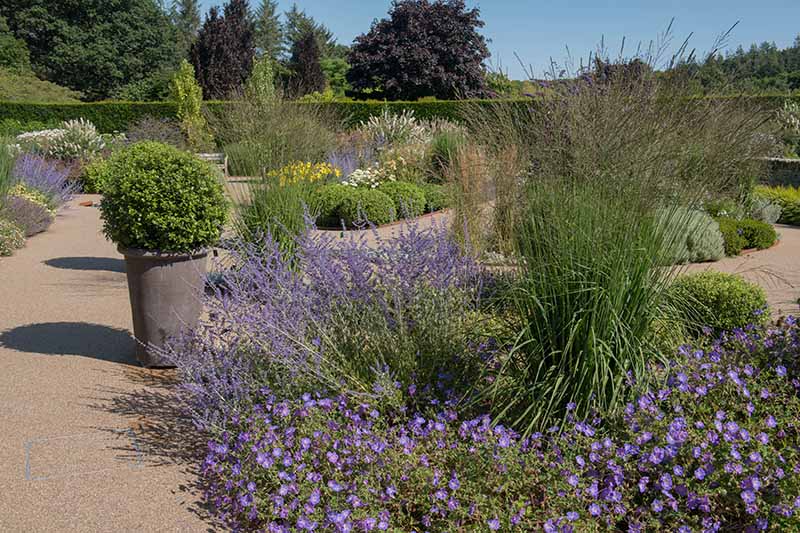
You may also consider growing it as a border or foundation plant, or as a short hedge of sorts, along walkways, or in a gravel garden.
Pollinators love the blooms, which serve to attract hummingbirds, bees, and butterflies.
Because the leaves and flowers of this plant are aromatic, you may also choose to cut sections to bring indoors and enjoy in a vase.
The leaves can also be dried for use in potpourri, and the flowers can be cut and dried for use in everlasting arrangements as well.
Quick Reference Growing Guide
| Plant Type: | Woody flowering ornamental shrub | Flower / Foliage Color: | Lavender-blue, purple/green-gray |
| Native to: | Asia | Tolerance: | Alkaline soil, drought, frost, rocky soil, salt |
| Hardiness (USDA Zone): | 3a-9a | Soil Type: | Loam |
| Bloom Time: | Spring-summer | Soil pH: | 7.0+ (alkaline) |
| Exposure: | Full sun | Soil Drainage: | Well-draining |
| Spacing: | 18-24 inches, or more depending on variety | Attracts: | Bees, butterflies, hummingbirds |
| Planting Depth: | Surface (seeds), 1 foot (transplants) | Companion Planting: | Coneflower, globe thistle, lavender, ornamental grass, sedum, sneezeweed |
| Height: | 36-48 inches, depending on variety | Uses: | Borders, cottage gardens, cut or dried arrangements, gravel gardens, hedges, xeriscaping |
| Spread: | 36-48 inches, depending on variety | Family: | Lamiaceae |
| Time to Maturity: | 4 years | Genus: | Salvia |
| Water Needs: | Low | Subgenus: | Perovskia |
| Maintenance | Low | Species: | Yangii |
| Common Pests: | Aphids, leafhoppers, slugs, spider mites, whiteflies | Common Diseases: | Cylindrosporium leaf spot, Phoma stem canker, root rot, Sclerotinia stem blight |
Heed Our Advice to Grow Beautiful Russian Sage
When it comes to growing ornamental shrubs, there are few plants that are quite as hardy and tough as Salvia yangii.
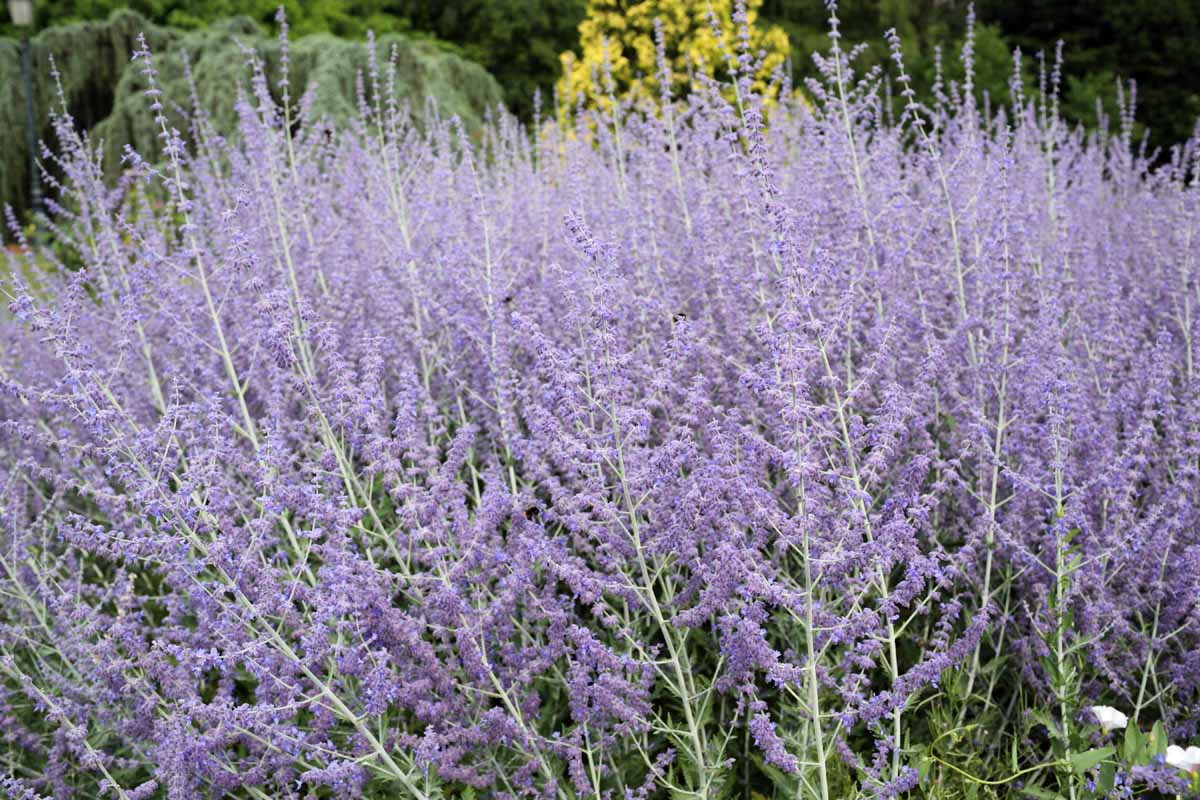
Once established, this plant is easy to grow and requires very little care. It is drought tolerant and offers brilliant color and fragrance to any setting in its recommended range.
Do you grow Russian sage in your garden? Let us know your favorite uses for this plant in the comments section below!
If you want to read more about growing and caring for ornamental shrubs, be sure to take a look at these articles next:
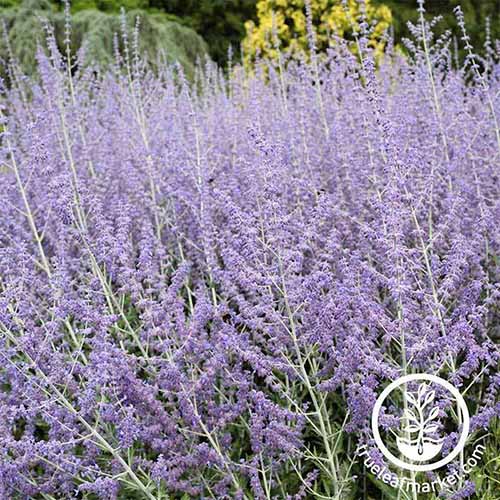
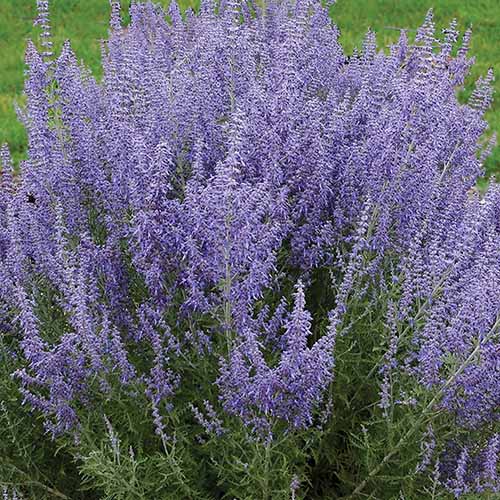
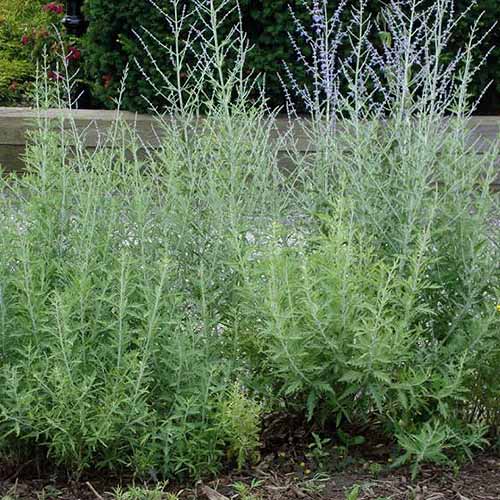
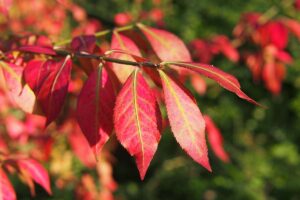
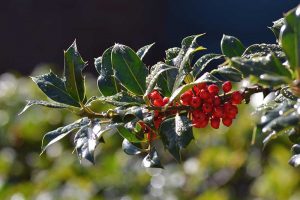

Does white Russian Sage have white flowers?
Hello Kerrie. Russian sage, Salvia yangii, does not have a cultivar with white flowers. The stems, though, can look so light and shimmery that they may appear to be white.
There are other types of salvia that do have white blooms, including ‘White Profusion,’ which is a Salvia nemorosa.
Good luck with all your flower selections, and happy gardening.
Thank you for the very detailed information about Russian Sage!
I am looking for help with growing Prairie Sage and can’t find any thing helpful online.
Do you know of any resources where I could get tips for growing prairie sage from seed?
Thank you.
Hello Den, and thanks for reading. Russian sage is part of the mint family, and while it’s not as delicious as culinary sage varieties, the blooms are still edible and a bit minty. Prairie sage, Artemisia ludoviciana, though, belongs to the sunflower family, Asteraceae. Its leaves and flowers are bitter and not suitable for cooking, though it once was a popular source of medicine. Prairie sage is a good choice for xeriscaping, and pollinators love it. The USDA has produced a fact sheet with some basics you might find useful. And be sure to consult our guide on starting garden… Read more »
We have four Russian Sage bushes that were planted in March 2019. They have full sun exposure and are thriving except for the fact that none of them have ever bloomed. Any suggestions?
Hello Jean, thanks for reading. There could be a few different reasons they aren’t blooming. First, if they’re growing in too-wet soil, they could be suffering from root rot. But I would be surprised if that were the issue since you say the stalks are thriving, just not blooming. It’s also possible the pH is out of their preferred range, which is alkaline, or at least 7.0. A soil test will tell you if the soil is too acidic. We offer tips on soil tests in this guide. I’m thinking the most likely explanation could be pruning at the wrong… Read more »